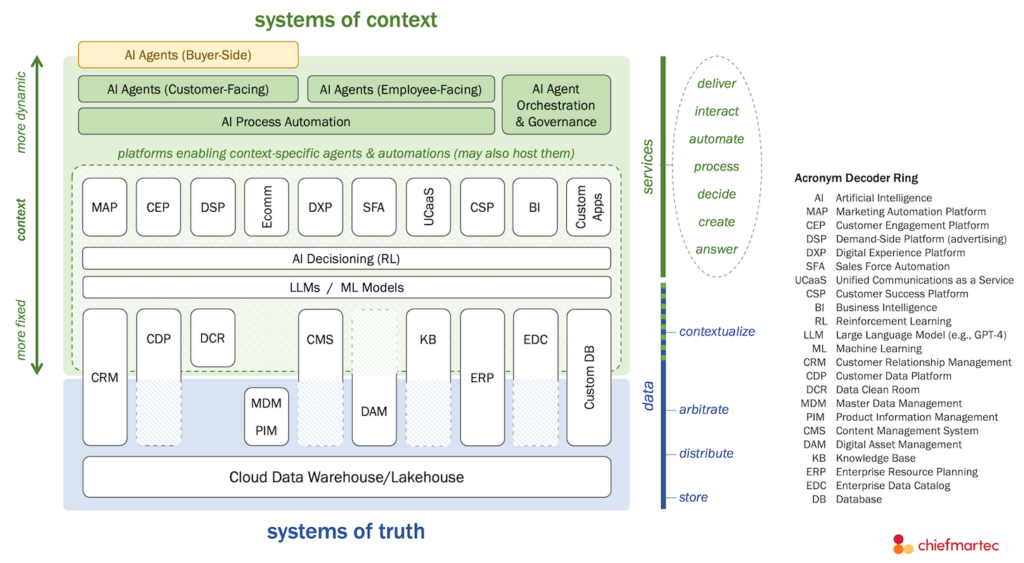I recently saw the movie Jurassic Park again. It’s about an island of cloned dinosaurs, intended as a kind of zoo and amusement park, that spirals out of control during a pre-opening inspection. Spiraling out of control is a euphemism for having ravenous pre-historic creatures devouring everyone in sight. (Remind anyone of their last budget meeting?)
It made me think of marketing automation.
One of the characters is a mathematician who specializes in chaos theory, Dr. Ian Malcolm (played brilliantly by Jeff Goldblum). Dr. Malcolm had been a critic of the park from beginning, predicting its collapse because chaos theory says that complex systems, with certain conditions, cannot be tightly controlled — such as the weather, global financial systems, and an ecology of dinosaurs on a 20th century island.
Dr. Malcolm’s warning: trying to force an overly simple management structure upon such a complex system is a recipe for disaster.
Complexity in marketing
I am fascinated by how complex marketing has become in the past decade. If you stop and think about the explosion of search marketing, social media marketing, email marketing, e-commerce web sites, mobile marketing, behavioral targeting, and budding semantic web marketing, it’s breathtaking.
But to fully appreciate the complexity generated by all this, consider how these new vehicles build upon each other:
- all the original marketing vehicles still exist and require attention;
- there are now all these new marketing vehicles (e.g., web site, search, email, social media, etc.);
- each of these new vehicles has near unlimited granularity (e.g., not unusual for a company to manage thousands of keywords in a search marketing campaign);
- the management of these different vehicles is often highly distributed across many people (e.g., the folks handling search may be far removed from the people running email campaigns);
- there are all sorts of interaction effects, within and between vehicles (e.g., a particular email campaign can trigger new searches — are the resulting messages consistent, or at least compatible?);
- particularly in social media — but also in search — end-users and third parties also drive the outcome, preventing marketing from predictably controlling those vehicles;
- virtual proximity multiplies the number of competitors, across more niches and more regions, and each of those competitors bring all the complexity above from their own marketing into the mix;
It’s not just that each new vehicle brings its own complexity to the table; each one simultaneously increases the complexity of all other vehicles too. This causes exponential growth in marketing complexity.
What’s interesting about this is that the actual atomic activity associated with these efforts can be quite simple — at least on the surface. What could be more straightforward than bidding on a keyword in Google AdWords, or posting a link to an article on Twitter?
The complexity comes as a result of lots and lots of these simple atoms bubbling up together into larger structures, catalyzing — and being catalyzed by — reactions in other vehicles. Ironically, the very simplicity that makes it so easy to create a single AdWords ad, causes hundreds or thousands of them to sprout up in unpredictable ways, generating a much more advanced kind of complexity.
This generates often surprising emergent behavior in the overall system.
The irony of marketing automation
The great irony of marketing automation is that it is often pitched as a way to simplify this exploding marketing universe, when in fact, it actually introduces a whole new layer of complexity itself.
Marketing automation, as it sounds, attempts to automate routine marketing processes. Marketers put in place software configurations and rules to handle various trigger events in a systematic fashion. For example, a prospect who fills out a lead generation form on a web site might be automatically queued to receive a series of follow-up “lead nurturing” emails over the next several months.
Sounds great, right?
There are two challenges with this, however, neither of which has been given due respect:
First, the model of interactions that are addressed by a marketing automation system are only an approximation of the real-world dynamics at play. This is by necessity — like trying to predict the weather, there are simply far too many variables all interacting together in the real world to accurately capture them all in a computer algorithm. The difference between the approximated model and reality creates a window for error. Over time, that window tends to grow larger. This is a classic phenomenon of the butterfly effect.
For instance, in our simple lead nurturing email example above, what happens if someone sends out a special offer email to all prospects — as a one-off campaign — that accidentally conflicts with the next email in the automated sequence? Ideally, you would want that scenario to be addressed by the automation system, but that might be beyond its model.
Second, marketing automation configurations and rules themselves introduce a new kind of variable into the environment. These modeled activities and the resulting actions they trigger are a whole new set of elements in the mix that have interaction effects with each other — and all the rest of your marketing initiatives.
Again referring to our lead nurturing example, before when there wasn’t an automated re-marketing program, you didn’t have to worry about one-off email campaigns conflicting with it. Now you do.
For a further dose of irony, the easier marketing automation software makes it to build up more and more automated programs and rules, the more complex the overall environment becomes.
And the example we’ve been looking at here is a very simple incarnation of marketing automation. In contrast, when you consider what multi-channel management and enterprise marketing management (EMM) software platforms are trying to do at a far grander scale, it’s hard not be skeptical — do these folks really think they can keep the dinosaurs penned in nicely bounded cages?
Taming the Tyrannosaurus
Despite my concerns, I’m not against using software to help with this brave new world of marketing. To the contrary, I think there’s tremendous opportunity at the intersection of marketing and computer science.
But as we push into this new era, I believe it’s critically important that marketers understand more deeply the complexity of their new environment. (What you don’t know can kill you!) That way, their strategies and tactics can be crafted with these dynamics in mind. In particular, I expect there will be an rising set of leadership principles in the marketing department around explicitly managing this complexity.
As this complexity begins to be appreciated for what it is, I think it will inspire a qualitatively different kind of software and management architecture to deal with it. It probably won’t embody the command-and-control heuristics of old-school marketing management so much as it will leverage the distributed and emergent nature of this new environment.
As Dr. Malcolm would say, “Life will find a way.”




Scott —
Very nice analogy! I work for a marketing automation vendor, but I’m also a physicist by training and have studied chaos extensively. It was exactly the kind of complexity you describe — in particular the fact that end-users and third parties introduce unpredictability into the equation, and the interaction effects between programs — that led us at Marketo to create a different type of user experience for marketing automation.
Marketing automation software can make the specific tasks of marketing easier, but it won’t ever make marketing itself easy.
Thanks, Jon.
What a great combination — marketer and physicist! I love it.
Will definitely be interesting to see how products in your space evolve. Sounds like you’ve got some novel ideas to embrace the complexity. That is, in my opinion, possibly the most fruitful area of innovation ahead of us. Good luck!
I think that you have to start with a strategic approach to your marketing automation so that it doesn’t get too out of control or overwhelming. If your marketing systems get to the point where you can’t see the outcome of testing because of overly segmented offers or if you can’t clearly report marketing results to your board then you have gone too far.
Marketing automation should allow you to simplify some tasks so you can push other areas further. For example, you can automate re-marketing efforts so that you can spend more time analyzing the effects of your re-marketing. And it allows marketers to put metrics to their actions so they know if their re-marketing efforts are working or just a wasted effort.
This new complexity is what excites the best marketers, driven to improve the results of their campaigns and prove the value of their efforts and contribution to the revenues generated by their organization.
I think what is important here is to recognize that it can get overcomplicated and complex and that there is a need to create structure around your campaigns and standard reporting so that you don’t lose sight of the aspects of it that are most important.
Thanks for a great post with an amusing reference to one of my favorite movies! 🙂
Hi, Maria. I agree that this new era is certainly exciting, opening the door to a whole level of marketing performance (and accountability) — if marketers leverage it correctly.
I think you’re on the right track: organizing management principles and heuristics to recognize the complexity and structure your strategies accordingly.
It will be very interesting to see the best practices that emerge around marketing automation. It’s still such a young field that we’ve only started to scratch the surface.
Marketing Automation and The End of Segmentation as You Know It
A few days ago I read Scott Brinker’s interesting post about “Marketing Automation and Jurassic Park”. In his post Scott points out the irony that many Marketing Automation vendors claim to simplify marketing but he perceives that in fact this…
Scott,
Thanks for the analogy, I wish they’d make more Jurassic Park films ;-). I agree with you on some of your points. In particular, the easier it is to create more lead nurturing campaigns the more complex marketing becomes.
One obvious solution is to not over complicate the concept of lead nurturing. Many companies use lead nurturing to automate, personalize, and route responses to web form submissions – and that’s it. I agree with Howard Sewell of Spear Marketing, 80% of the benefit of lead nurturing comes from the first 20% of effort (http://spearmarketing.com/blog/lead-nurturing-the-8020-rule/). It’s the marketing automation vendors responsibility to train their customers to start simple and, if necessary, expand their lead nurturing campaigns.
Kindly note, lead nurturing (as well as marketing automation) are a just a few features of what we call refer to as “revenue generation software”. There are a host of other features that simplify marketing processes such as lead generation, landing page creation, web form design, lead qualification, email marketing, and a number of other capabilities. The key point is these features automate what most marketers do manually today. I liken it to a stick shift transmission. If everyone drove a stick shift I’m convinced driving be a complex process and we’d have many more accidents on the roads. Fortunately, we’ve got automatic transmissions that operate the car in the same way – but automates shifting, making it easy for the drivers.